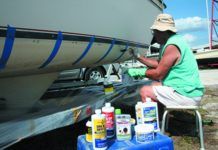Re-torque On Time
I have a Yanmar 4jh2-te engine with 700 hours (1997) that runs great andhas never overheated. At an engine seminar I was advised that thecylinder head should be re-torqued at about 600 hours. Since I tend tofollow the old axiom “if it ain’t broke…” I am reluctant to open up the thing and follow this advise. I wonder how many people are even aware of this “need” and whether it is really needed, or just a practice from the past, no longer needed for new engines with modern materials, that is being preserved by mechanics that like to open up perfectly good engines.
Thanks for a great magazine.
-Juan Florin
Via e-mail
We’d go ahead and do it, or have it done. It’s not a difficult or expensive job (given decent access to the cylinder head). It can’t hurt, and it’s likely to help preserve the engine (600 hours is pretty young for a diesel, after all, and this would be the time when you’d expect to have finished the full break-in). Just to make sure, we checked with our diesel expert, Mike Muessel of Oldport Marine in Newport, RI. (He is a Yanmar dealer.) He said, “Retorque the head at 500 hours to help prevent a head gasket blow-up.”
———-
Consider Plastic Fuel Tanks
I know this subject has been covered in the past but the past articles are eluding me. I want to add an aluminum fuel tank to a cockpit locker and remember reading a recommended alloy and method of mounting the tank so as to minimize surface corrosion. Could you point me toward those answers again, please?
-Jim H.
Everett, WA
You may be thinking of an exchange in a PS Advisor of November 1, 2001.We quote again from the ABYC recommendations: “For [aluminum fuel tanks]… all non-integral tank supports, chocks, or hangers shall be separated from the tank surface by a non-metallic, non-moisture-absorbent, non-abrasive material suitable for the purpose, e.g. neoprene, Teflon, and high-density plastics, that shall adhere to the tank.”
The idea is not to try to cushion the tank with any padding or foam that will absorb moisture. The installation needs good air circulation to prevent crevice corrosion.
Since you seem to have room and clearance, it might be a good idea to look into installing a plastic fuel tank. That eliminates the corrosion problem altogether. Vetus sells them. See the following web page: www.vetus.nl/producten/product_main_4_2.asp.
———-
Dark Water Stains
A leaking chainplate has caused a dark water stain to appear in some of the teak in the cabin. I fixed the leak, but I’m left with the stain. It appears to go fairly deeply into the wood. I understand that there’s a process that will remove this stain. Do you happen to know, or do your readers know, what it is?
-Pete Ellison
Via e-mail
Our impression is that if the end grain of any unsealed wood is subjected to a liquid, the game is over. The long cells of wood permit the liquid to travel between the cells and create deep stains that cannot be removed. (Why the stains remain dark, we don’t know.) But that’s why valuable wood in a lumberyard has the cut ends sealed, usually with paint, to keep rain and moisture out of the end grain.
Woodworkers permit the wood to reach the moisture content they want and then seal the ends.
We’ve had several experiences that fuel these impressions. For example, a deck leak developed in a ketch we owned. It had a teak deck and mahogany-paneled interior. The leak (they frequently follow torturous paths) somehow found itself into some 2-1/2″ mahogany pieces, and produced dark stains. We tried several fixes, but the vertical pieces eventually had to be torn out and replaced with new wood.
Another instance: Years ago we installed a teak parquet floor. A couple of years after that, a fine Airedale pup got caught short and deposited a goodly puddle on the teak. The urine penetrated the parquet’s varnish at the cracks and left dark stains. Over several months of desperate effort, we tried plain water, mild bleach, strong bleach, oxalic acid, and finally hard sanding. Nothing did any good. We gave up, and in the intervening years have just gotten used to it. Sort of.
Finally, we’ve just checked with an antique furniture restorer, who tells us that endgrain stains run all the way through the wood and are not removable-but let’s hear from any readers who know something that works.





































